HP Victus 15L (2022) Review
A big-brand, compact and affordable gaming PC
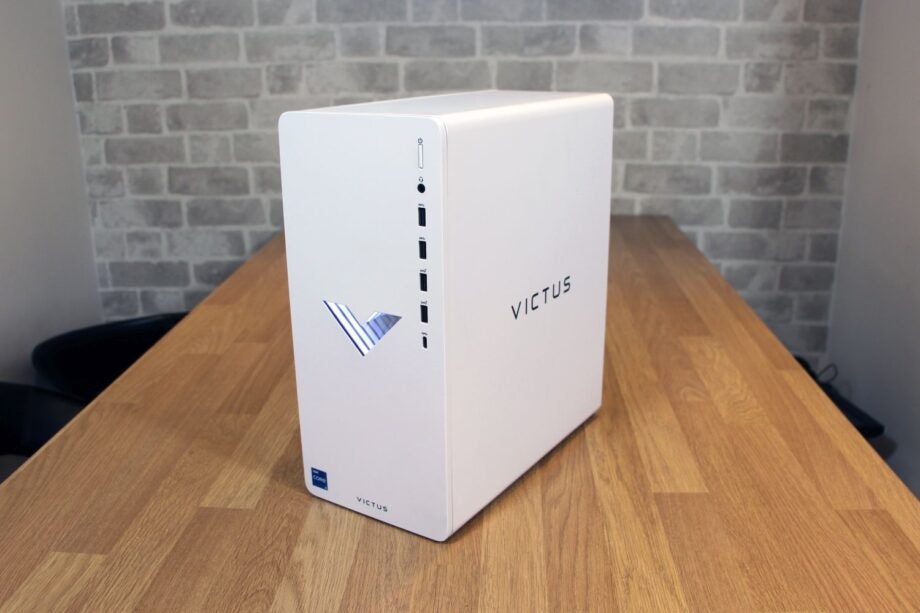
Verdict
The HP Victus 15L is compact, good-looking and has the power for everyday gaming – and the price isn’t bad. But it’s too basic in too many areas, so you’ll get a better deal if you’re willing to shop around.
Pros
- Solid 1080p and esports gaming power
- Compact, robust and good-looking enclosure
- Always cool and quiet
- Relatively affordable
Cons
- Basic motherboard
- Single-channel memory
- Restrictive case
- Outdated components
Availability
- UKRRP: £979
- USARRP: $979
- EuropeRRP: €1499
Key Features
- A compact, good-looking caseThe HP Victus 15L is small and sturdy, so it’s an ideal gaming PC for a bedroom or for frequent travellers. It looks good, too, especially thanks to the “infinity mirror” on the front panel, and its front section also has plenty of ports.
- Nvidia GeForce RTX 3060 graphics The Nvidia GeForce RTX 3060 may not be the newest or the most powerful graphics card around, but it’s still got enough power to scythe through single-player games at 1080p and esports games on rapid refresh-rate panels – so it’s a good everyday chip.
- Intel Core i5-12400 processorThe Intel Core i5-12400 is a mid-range chip that’s got the power for everyday office tasks and web browsing, but in this PC it’s undermined by HP’s reliance on single-channel memory.
Introduction
I don’t expect big, mainstream companies to do a particularly good job with gaming PCs, but that doesn’t stop them trying – and the HP Victus 15L is the latest system to attempt to win me over.
At first glance, the Victus has several attributes that work in its favour. It’s got Nvidia GeForce RTX 30-series graphics cards alongside decent processors from Intel and AMD. It’s also good-looking and compact, so it should be easy to slot this rig into a cramped bedroom – or sling it in a bag to take to LAN parties.
The model I’ve reviewed costs £979 in the UK, $979 in the US but €1499 in Europe, so the price isn’t bad either, and plenty of alternative specifications are available.
I’ve gone hands-on with this PC to find out if you should invest in this big-brand gaming rig – and I’ve also explored which specifications are worth your money.
Design
- A good-looking, compact and robust enclosure with a slick “infinity mirror” feature
- Plenty of ports on the front, but not so many around the back
- A basic interior with hardly any upgrade paths, so it’s no good for tinkering
No matter which specification you buy, you’ll get a good-looking PC with the Victus. It’s available in black and white, and the front of the tower has an “infinity mirror” that does clever tricks with foils and lights to make it seem like a tunnel descends into the PC. It’s eye-catching.
The Victus impresses in some practical departments, too. The outside is sturdy enough for gamers to sling the unit into a backpack. At 155mm wide and just 337mm tall it’s half the size of conventional enclosures, and it only weighs 6.31kg.
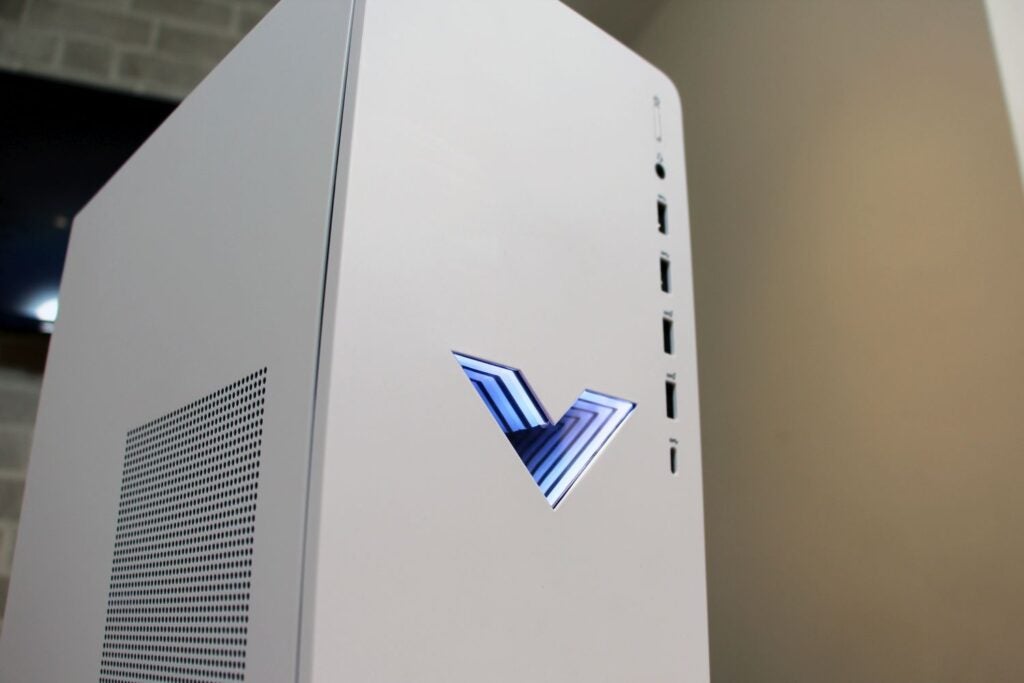
On the front you’ll find two USB 3.2 Gen 2 ports, two USB 3.2 Gen 1 sockets and a sole USB 3.2 Gen 1 Type-C connector, so that’s plenty of room for peripherals and external storage. Around the back it’s less impressive: you only get four sluggish USB 2.0 ports and three audio jacks.
The HP isn’t impressive on the inside, either. There are only two memory slots and a modest CPU cooler. Users can add one 3.5in hard disk, but that’s it – there’s no space for extra storage, larger graphics cards or more ambitious cooling. You don’t get windows or elaborate lighting, either.
Still, PCs like the HP aren’t designed to be opened and upgraded like systems from specialist builders. But if you want to start tinkering, remember that even modest PCs from other companies will have more space for storage, graphics cards and cooling. You’ll also get more ambitious motherboards and extra ports.
Performance
- Enough gaming power to tackle 1080p titles and the key eSports games
- The processor is fine for everyday use, but undermined by the single-channel memory
- Shop around elsewhere and you’ll find better motherboards, memory configurations and cases
The HP Victus 15L I’ve reviewed gets graphical grunt from the Nvidia GeForce RTX 3060, which is a mid-range core with 12GB of memory. It runs at its peak 170W power limit in this PC, which means a boost clock of 1777MHz. The Core i5-12400 is another mid-range part, and Intel’s chip includes six P-cores that peak at 4.4GHz.
Elsewhere, HP’s rig includes a 1TB WD SN810 SSD with excellent read and write speeds of 6,959MB/sec and 5,299MB/sec. Connectivity comes from Gigabit Ethernet, dual-band Wi-Fi 6 and Bluetooth 5.2. It’s not the 2.5Gbps Ethernet and Wi-Fi 6E you’ll get from proper gaming rigs, but it’ll do the job for mainstream gaming.
The 16GB of memory is DDR4 rather than DDR5, and it’s installed in a single-channel configuration – so performance suffers. Users can add a second 16GB stick, but not everyone will be comfortable making the upgrade and that adds cost. The motherboard is basic, too, without the slots, tweaking features or RGB LEDs you’ll find elsewhere.
Despite that, the HP supplies solid gaming performance. It played Horizon Zero Dawn’s 1080p benchmark at 102fps, and delivered an 81fps average at 2560 x 1440 – with both runs at Ultimate settings. Borderlands 3 is even trickier to play smoothly, and at those resolutions the Victus averaged 77fps and 56fps.
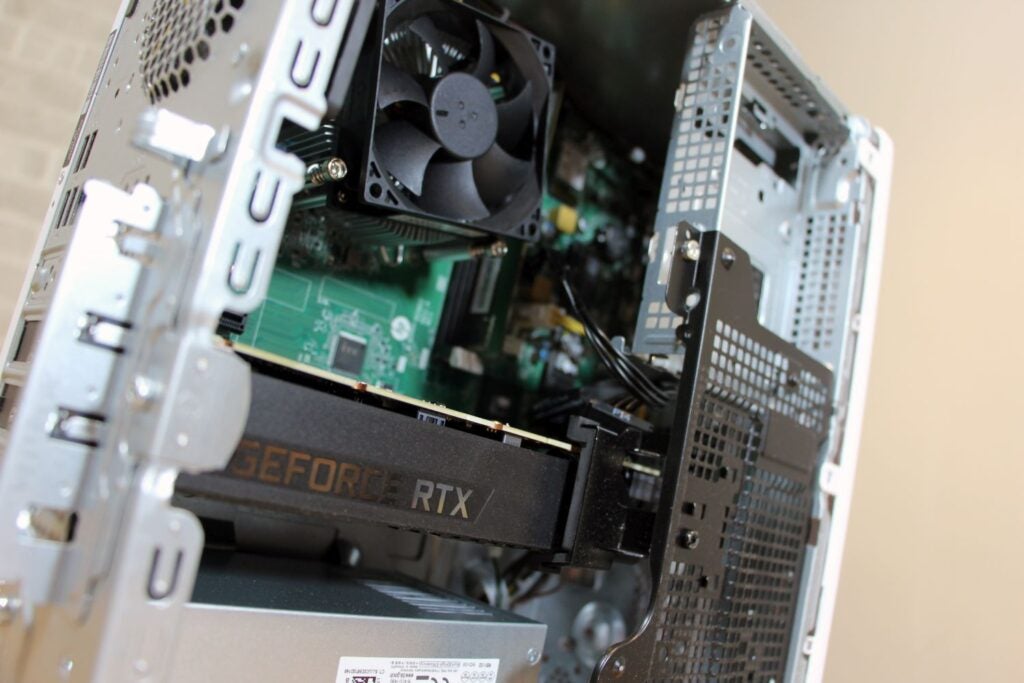
That’s enough speed to play today’s top single-player games on 1080p and 1440p displays without big settings compromises. There’s esports potential here, too: a Rainbow Six Siege 1080p average of 304fps means that most competitive games will run well on 240Hz and 360Hz displays. The HP also made hardly any noise – it’s always cool and quiet.
This is a mid-range card, so it can’t handle 4K gaming or the largest widescreens. I saw no significant performance gains from HP’s boost mode, either. And while its 3DMark Time Spy score of 8396 is decent, you’ll see a few hundred points more from PCs with dual-channel memory.
It’s also worth thinking about other specifications. In the UK and the US, the Victus costs £979 and $979 with the RTX 3060. However, it’s available with the RTX 3060 Ti and a better CPU for £1,079 and $1,209. If you want more gaming headroom for the future, or if you want to play at 2560 x 1440 or on widescreen displays, that’s a worthwhile upgrade. It’s better with ray tracing, too. The European version of the Victus always comes with the RTX 3060 Ti.
That’s the only graphics change I can recommend. This PC is sometimes sold with the AMD Radeon RX 6600 XT, but it’s slower than the RTX 3060 and prices don’t differ too much, so don’t bother.
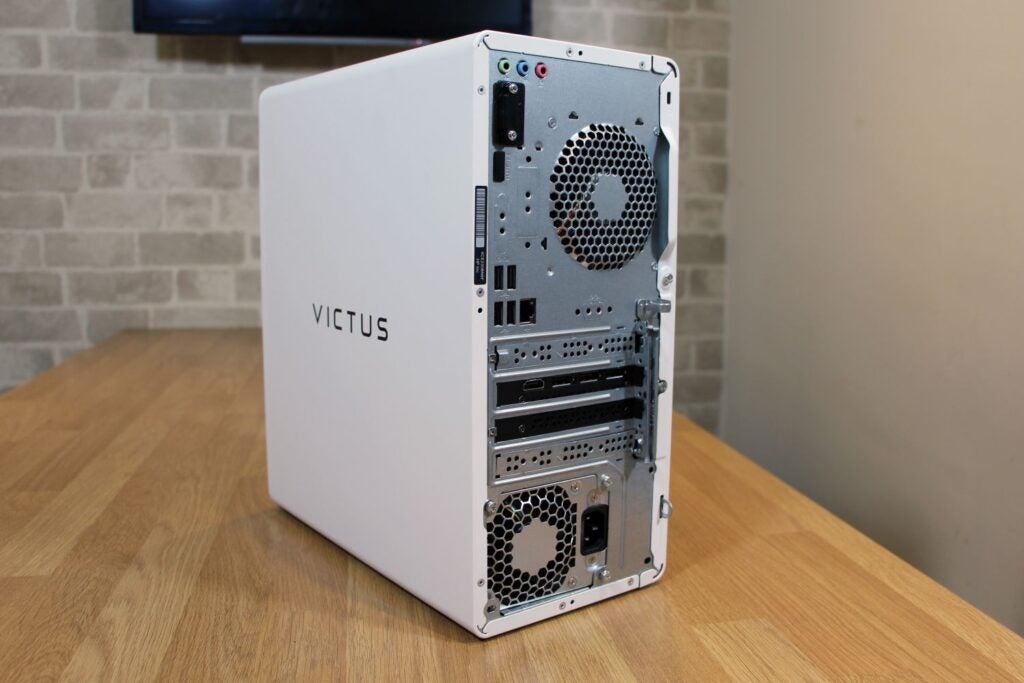
I’ve also seen older versions of this PC with GPUs like the GTX 1660 Super or RTX 2060, and they’re all worth avoiding.
If you’re particularly keen about gaming then it’s worth waiting before buying, too. Nvidia will soon be filling out its GeForce RTX 40-series range of GPUs, and the RTX 4060 will offer a big performance boost over the RTX 3060.
It’ll cost more – and those cards may never arrive in the Victus 15L – but keen gamers will want to shop around and consider saving some extra cash for an RTX 40-series PC later in the year.
Switch to the processing side and you’ll find a mid-range chip that’s hampered by the HP’s single-channel memory. In Geekbench 5 the i5-12400 usually scores around 1700 and 8600 points in the single- and multi-core benchmarks – but this rig only managed 1573 and 6957. In PCMark 10 the i5-12400 can score nearly 8000 points, but here it topped out at 7286.
Those results are not ruinous. You’ve got enough power to handle web-browsing and office tasks, but the processor doesn’t reach its full potential when it comes to creative workloads and multi-tasking – you’ll notice slowdown if you have lots of apps open at once, or if you want to do some photo-editing.
The Victus is sold with several different processors, but not all are worth considering. Many versions of this rig come with the Intel Core i7-12700F, which is a great upgrade – you get two more P-cores, four E-cores and faster speeds. It’s more capable with multi-tasking and creative workloads.
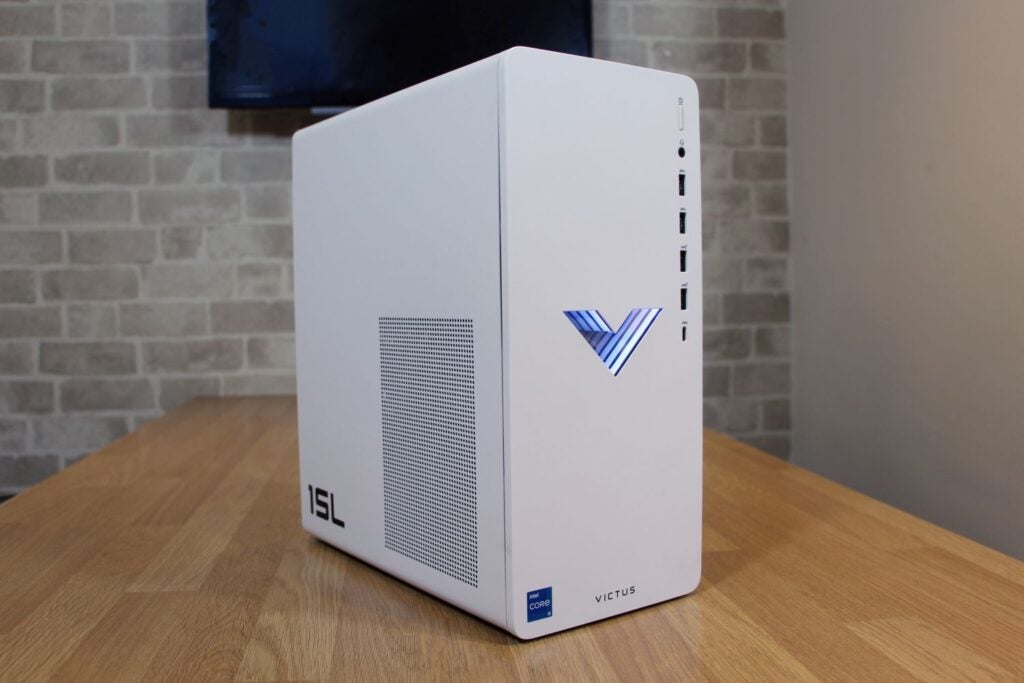
Other Victus variants are available with the AMD Ryzen 5 5600G and Ryzen 7 5700G. The Ryzen 5 5600G is just as good as the i5-12400, but the Ryzen 7 5700G can’t compete with the i7-12700F. And don’t fall foul of the Core i3-12100F model – it’s very slow. Also bear in mind that Intel 13th Gen processors are now available, and they’re a bit faster than all of the chips we’ve mentioned here – albeit at a higher price.
You should also consider your options in the wider market. If you’re willing to spend around £1000 or $1000 (or a little more) on a PC from a bespoke builder then you’re going to get a similar level of performance to the HP, but those rigs will have better motherboards, cases and memory configurations. Most will have better warranties, too: the HP has a one-year deal, but boutique firms offer three- and five-year deals.
In the US, look at companies like CyberPower, Origin and iBUYPOWER – in the UK, consider builders like Scan, Chillblast and Overclockers. The price may be higher, but your money will go further.
That said, there are still reasons to buy the HP. It’s got enough gaming and processor power to handle mainstream tasks and everyday computing. It’s not particularly expensive, and it’s quiet and compact. You may also want the balm of buying from a big brand.
If you’re willing to shop around, though, you’ll find more versatile, well-balanced PCs with better warranties and often with better customer service. The Victus is a decent big-brand effort, but gaming PCs remain far better elsewhere.
Latest deals
Should you buy it?
You’d like a compact, unfussy gaming PC for 1080p titles and esports
The Victus is small and sturdy, and its RTX 3060 handles Full HD gaming and esports titles without breaking a sweat – and the price is decent, too.
You’d prefer something faster, or a PC you can upgrade
You’ll easily find faster components if you shop around or spend more, and the Victus has a very basic case that isn’t ideal for upgrading in the future.
Final Thoughts
The HP Victus 15L has enough gaming power for 1080p titles and eSports inside a compact, good-looking case, and elsewhere it has quiet operation and a reasonably low price. It’s an unfussy, basic gaming PC, but you’ll get a better case, motherboard and selection of components if you shop around elsewhere.
How we test
Every gaming PC we review goes through a series of uniform checks designed to gauge key aspects including build quality, performance, and accessibility.
These include formal synthetic benchmarks and scripted tests, plus a series of real-world checks, such as how well it runs an AAA game.
We used it as our main desktop PC for at least a week.
We tested the performance via both benchmark tests and real-world use.
FAQs
The HP Victus 15L has a one-year warranty deal.


